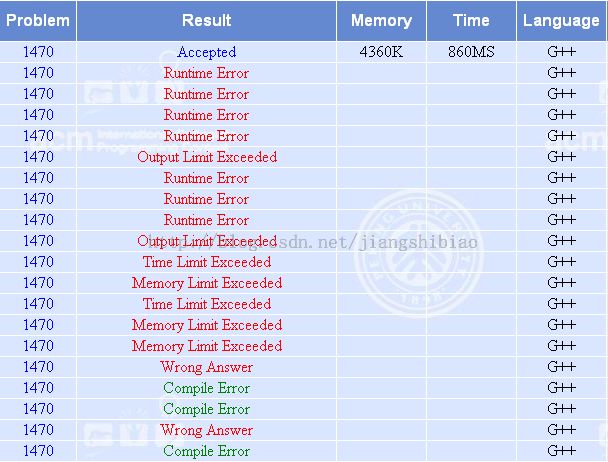LCA的tarjan求法&&POJ 1470的辛酸历程
转载请注明出处:http://blog.csdn.net/jiangshibiao/article/details/23659735
【LCA的线性解法】LCA(最近公共祖先)的问题十分常见。以前我单纯的认为,每次O(N)扫一遍每个节点的深度、再直接暴力求LCA的效率很高——Nlog(N)。但是往往树会退化成链(或者说它不平衡),如果询问次数多的话肯定TLE。离线解法TARJAN(这人好厉害,强连通算法也是他发明的)的效率则是O(N+Q),其中Q是询问个数。
【原理】用到了并查集的思想,每次对于一个点,处理询问中与他有关的一些点,最后链到它的父亲中。递归实现。
【伪代码】
【原题】
| Time Limit: 2000MS | Memory Limit: 10000K | |
| Total Submissions: 14300 | Accepted: 4604 |
Description
Input
nr_of_vertices
vertex:(nr_of_successors) successor1 successor2 ... successorn
...
where vertices are represented as integers from 1 to n ( n <= 900 ). The tree description is followed by a list of pairs of vertices, in the form:
nr_of_pairs
(u v) (x y) ...
The input file contents several data sets (at least one).
Note that white-spaces (tabs, spaces and line breaks) can be used freely in the input.
Output
For example, for the following tree:

Sample Input
5
5:(3) 1 4 2
1:(0)
4:(0)
2:(1) 3
3:(0)
6
(1 5) (1 4) (4 2)
(2 3)
(1 3) (4 3)
Sample Output
2:1 5:5
Hint
Source
【大意】给定一棵树的结构和一些询问(x,y),求x和y的LCA。输出每个点它成为多少点对的答案。
【初始代码】
#include<cstdio>
#define N 1005
using namespace std;
char ch;
struct arr{int next,go;}a[N*2];
struct ARR{int NEXT,GO;}A[N*2];
int f[N],x,y,num,n,m,i,ans[N],cnt,CNT,end[N],END[N],root;
bool visit[N],flag[N*2];
inline int Read()
{
while (ch<'0'||ch>'9') ch=getchar();int s=0;
while (ch>='0'&&ch<='9') s=s*10+ch-48,ch=getchar();return s;
}
inline void add(int u,int v) {a[++cnt].go=v;a[cnt].next=end[u];end[u]=cnt;}
inline void ADD(int U,int V) {A[++CNT].GO=V;A[CNT].NEXT=END[U];END[U]=CNT;}
inline int get(int u){return f[u]==u?u:f[u]=get(f[u]);}
void tarjan(int k)
{
f[k]=k;visit[k]=true;
for (int i=end[k];i>=0;i=a[i].next)
{
int go=a[i].go;
if (!visit[go])
{
tarjan(go);f[go]=k;
}
}
for (int i=END[k];i>=0;i=A[i].NEXT)
{
int GO=A[i].GO;
if (visit[GO]&&!flag[i]) ans[get(GO)]++,flag[i]=true,flag[i^1]=true;
}
}
int main()
{
scanf("%d",&n);ch=' ';cnt=CNT=-1;
for (i=1;i<=n;i++) end[i]=END[i]=-1;
for (i=1;i<=n;i++)
{
x=Read();num=Read();if (i==1) root=x;
while (num)
{
num--;y=Read();add(x,y);add(y,x);
}
}
m=Read();
for (i=1;i<=m;i++)
x=Read(),y=Read(),ADD(x,y),ADD(y,x);
tarjan(root);
for (i=1;i<=n;i++)
if (ans[i]) printf("%d:%d\n",i,ans[i]);
return 0;
}
【悲惨经历】几乎什么问题都被我碰上了。
【注意点】
①给定的是有向边。
②根要自己找。我一开始以为是无向边,这样无法获取根的位置,于是我默认第一个输入的点是根~~
③读入注意一下。(我觉得我的读入优化应该没问题,虽然AC代码中改成了scanf)
④有些时候会重复计算。因为是有向边,我们可以把visit[k]=true移到中间,这样就不会重复计算了。(当然麻烦点也可以,我原来是开边表的,多开一个bool数组判重也可以)
⑤英语渣,没看出来——有多组数据。
⑥因为有多组数据,所以每次要好好的清零。
以上的改好后,我就一直RE,后来去网上找题解,它们说询问要用邻接矩阵来记录。为什么呢?原来可能有多次重复询问(这题目太坑了,竟然没说询问个数)或者询问的很多,邻接矩阵还能记录重复的询问。
最终,A掉了。真是感慨万千啊!
【AC代码】
#include<cstdio>
#include<cstring>
#define N 1005
using namespace std;
char ch;
struct arr{int next,go;}a[N*2];
int f[N],x,y,num,n,m,i,ans[N],cnt,CNT,end[N],END[N],root,fa[N],ask[N][N];
bool visit[N];
inline void add(int u,int v) {a[++cnt].go=v;a[cnt].next=end[u];end[u]=cnt;}
inline int get(int u){return f[u]==u?u:f[u]=get(f[u]);}
void tarjan(int k)
{
f[k]=k;
for (int i=end[k];i;i=a[i].next)
{
int go=a[i].go;
tarjan(go);f[go]=k;
}
visit[k]=true;
for (int i=1;i<=n;i++)
if (visit[i]&&ask[k][i])
ans[get(i)]+=ask[k][i];
}
int main()
{
while (scanf("%d",&n)!=EOF)
{
memset(end,0,sizeof(end));
memset(ask,0,sizeof(ask));
memset(ans,0,sizeof(ans));
memset(fa,0,sizeof(fa));
memset(visit,0,sizeof(visit));
cnt=0;CNT=0;
for (i=1;i<=n;i++)
{
scanf("%d:(%d)",&x,&num);
while (num)
{
num--;scanf("%d",&y);add(x,y);fa[y]++;
}
}
scanf("%d",&m);
for (i=1;i<=m;i++)
scanf(" (%d %d) ",&x,&y),ask[x][y]++,ask[y][x]++;
for (i=1;i<=n;i++)
if (fa[i]==0) {root=i;break;}
tarjan(root);
for (i=1;i<=n;i++)
if (ans[i]) printf("%d:%d\n",i,ans[i]);
}
return 0;
}
